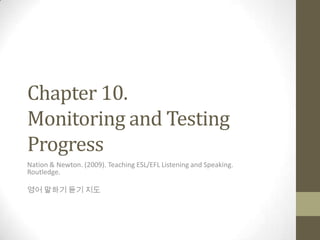
Chapter 10
- 1. Chapter 10. Monitoring and Testing Progress Nation & Newton. (2009). Teaching ESL/EFL Listening and Speaking. Routledge. 영어 말하기 듣기 지도
- 2. Monitoring Progress 1. Where possible, get learners to keep a record of their performance on regular classroom activities. 2. The teacher uses simple observation checklists when learners are performing listening and speaking activities. 3. The teacher gets learners to do regular self-assessment of their progress. 4. The teacher crosses items off a syllabus list when satisfied that the learners are able to cope with that part of the syllabus. 5. The learners build up a sequenced portfolio of completed activities and feedback. 6. The teacher does regular testing.
- 3. Reliability 1. A reliable test is one whose results are not greatly affected by a change in the conditions under which it is given and marked. 2. How to secure reliability: test/retest / split halves / two equivalent forms of the same test 3. A reliable test is not necessarily a valid test, but an unreliable test cannot be valid.
- 4. More reliable tests 1. A listening test will be more reliable if the material that the learners listen to is on tape. 2. A test is more reliable if it has several points of assessment. 3. A test is more reliable if it can be marked in relation to a set of correct answers or if the marking is based on clearly understood criteria. 4. A test will be more reliable if the learners are all familiar with the format of the test.
- 5. Brainstorming on Content Validity • What components of listening are not included in dictation? What are the components of dictation which are not typically part of the listening skill? Is the process of listening to a dictation like ordinary listening?
- 6. Validity 1. Face validity 2. Content validity 3. Ecological validity See 168 for an example
- 7. Practicality 1. Tests have to be used in the real world where there are limitations of time, money, facilities and equipment, and willing helpers. 2. Considerations: (1) economy of time, money, and labour; (2) ease of administration and scoring; (3) ease of interpretation. • It is not easy to meet all these requirements and still have a reliable and valid test. • Most tests are a compromise between the various criteria. When making the compromise it is important that validity is not lost.
- 8. “Washback” Effect • the influence of the form and the content of the test on the classroom • Positive/Negative washback
- 9. Types of Listening Tests • Dictation • Partial Dictation • Text with Questions • Responding to Statements • Three Choice True-false • Recorded Cloze • Information Transfer • Rating Scales and Lists
- 10. Example: The Australian Second Language Proficiency Ratings Source: http://www.apec.edu.tw/research/eng_3_1.php
- 11. Types of Speaking Tests • Interviews and Scales • Group Oral Exam • Dycoms (Split Information) • Describe and Draw • Conversational Cloze • Multiple-choice Speaking Tests • Imitation • Role Plays
